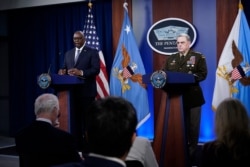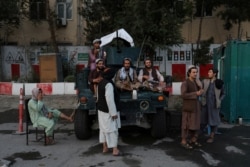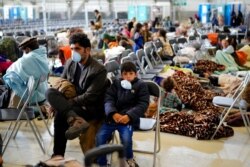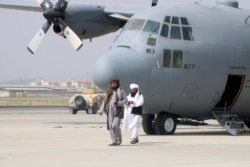Senior American officials are painting a very different picture of the United States' last days in Afghanistan and the rushed evacuation of more than 124,000 civilians, described by U.S. President Joe Biden as an "extraordinary success."
While describing the 18-day airlift as "heroic" and the largest in U.S. history, the officials also talked about their pain, anger and regret over the Afghans left behind, including many who had qualified for U.S. Special Immigrant Visas.
"I would say it's the majority of them," a senior State Department official involved in the evacuation operation said Wednesday, when asked how many SIV applicants had not made it out.
"Everybody is haunted by the choices we had to make and by the people we were not able to help," the official said. "It involves some really painful trade-offs and choices."
"We unfortunately had to start prioritizing the people to whom we had a legal obligation first and foremost, and that was our fellow American citizens," the official added.
U.S. defense officials also expressed their frustration, despite praise from Defense Secretary Lloyd Austin for the heroism of the troops overseeing the evacuation.
"No operation is ever perfect," Austin told reporters in his first public remarks since the U.S. war in Afghanistan officially ended.
"The SIV program is obviously not designed to accommodate what we just did," he added. "For the type of operation that we just conducted, I think we need a different type of capability."
The highest-ranking U.S. military officer was equally blunt.
"When we see what has unfolded over the last 20 years and over the last 20 days, that creates pain and anger," General Mark Milley, chairman of the Joint Chiefs of Staff, told reporters.
"War is hard. It's vicious, it's brutal, it's unforgiving. And yes, we all have pain and anger," he said.
The Pentagon said Wednesday that by the time the last U.S. plane took off from Kabul airport, the U.S. and its coalition partners had evacuated 124,334 civilians from Afghanistan, including almost 6,000 Americans.
According to officials, about 43,000 of the evacuees are currently at 14 staging bases across nine countries, with another 20,000 Afghans at various bases in the United States.
"Our counterterrorism efforts in Afghanistan and the region over 20 years has protected the American people from terrorist attack," Milley said, adding, "It was not in vain."
"The men and women and children who were just evacuated will ultimately be the legacy to prove the value of our sacrifice," he said.
Both Milley and Austin said the Pentagon would closely review what happened in Afghanistan, including the evacuation, to see what lessons could be learned. They also said the U.S. military would continue to help evacuate Americans and Afghans under the direction of the U.S. State Department, which is now leading the evacuation effort.
Where those efforts stand, though, is not clear.
State Department spokesperson Ned Price told reporters Wednesday there are between 100 and 200 U.S. citizens still in Afghanistan. He said when there are options available for those who still want to leave, “We will communicate directly to them personalized instructions on what they should do, when they should do it, and how the United States Government feels we are best positioned to help them do that.”
Undersecretary for Political Affairs Victoria Nuland told reporters that the State Department’s Afghan Task Force was working on evacuation efforts around the clock, trying to help Afghans who partnered with the U.S.
“They are also on our priority list, if they are still in Afghanistan, to try to help them to evacuate if they so wish or if they are at risk,” Nuland said.
The White House, meanwhile, said U.S. officials were “working though” a number of issues to allow Americans and Afghans to leave, even without the presence of U.S. troops.
Those efforts include discussions to get Hamid Karzai International Airport in Kabul, and other airports across Afghanistan, up and running again, as well as trying to secure “overland” routes so people can leave by car or foot.
The White House also defended its overall effort, pushing back against claims that many Afghans were left in the lurch as U.S. troops pulled out for the final time.
At a briefing with reporters, press secretary Jen Psaki was asked about the State Department official’s belief that fewer than half of the at-risk Afghans had been evacuated.
While not directly answering the question, she said that "77% of the people who were evacuated were Afghans at risk."
"Are there more people who want to leave Afghanistan? Absolutely," she continued. "Our commitment to people who want to evacuate, want to leave — American citizens, journalists, Afghan partners who have stood by our side — is enduring and remains."
State Department officials said Wednesday that the 77% figure referred not to the total number of people evacuated from Afghanistan but only to some 31,000 evacuees who are already in the United States.
The total number of at-risk Afghans who got out is still unknown, State Department officials said.
VOA's Patsy Widakuswara, Anita Powell and Nike Ching contributed to this report.













